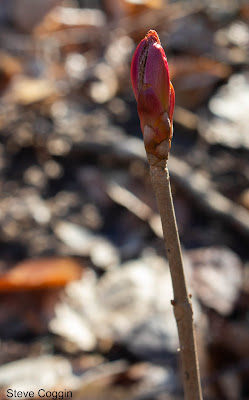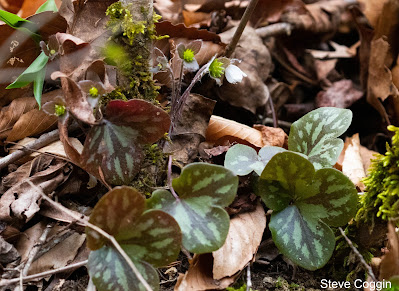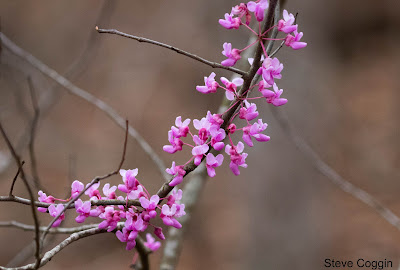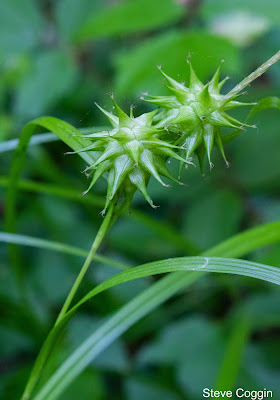Boone’s Cave is a park in Davidson
County, North Carolina. The Boone’s Cave
Park covers 110 acres of forested hills and ravines on the banks of the Yadkin
River. Squire and Sarah Boone were early
white settlers in the region. Their son
Daniel went on to fame as a frontiersman and explorer in the 18 century. The park boasts several small caves
overlooking the Yadkin River and local lore has Daniel Boone using
them to hide from hostile Native Americans. Starting
in March, 2022 Diane and I made regular visits to Boone’s Cave to document the
plants as spring came forth.
 |
| The mouth of Boone's Cave above the Yadkin River in Davidson County, North Carolina. |
 |
| The Boone Memorial at Boone's Cave Park, North Carolina. |
As spring came on in March, temperatures were cool and slanting sunlight illuminated the forest floor. Early Saxifrage (Micranthes virginiensis) was growing on the wet cliffs near the cave and putting out its first tentative buds. Later in the month these plants had grown new leaves and were producing many white flowers.
 |
| Early Saxifrage (Micranthes virginiensis) in flower. Boone's Cave Park. |
 |
| Painted Buckeye (Aesculus sylvatica) leaf bud. Boone's Cave Park, North Carolina. |
 |
| Young leaves of Painted Buckeye. Boone's Cave Park, North Carolina. |
 |
| Buckeye leaves were expanding by the end of March. Boone's Cave Park, North Carolina. |
 |
| Hepatica americana in flower. Boone's Cave Park, North Carolina. |
 |
| Hepatica plant in fruit. Boone's Cave Park, North Carolina. |
 |
| Bloodroot (Sanguinaria canadensis) leaf and flower. Boone's Cave Park, North Carolina. |
Windflowers (Thalictrum thalictroides) with their bright white petals were also early bloomers in the ravines of Boone's Cave.
 |
| Windflower (Thalictrim thalictroides) flowers. Boone's Cave Park, North Carolina. |
Spring really took off in April
with longer days and higher temperatures.
Trees were in flower including Flowering Dogwood (Cornus florida) and Carolina Silverbell (Halesia carolina).
 |
| Flowering Dogwood (Cornus florida) in flower. Boone's Cave Park, North Carolina. |
 |
| Carolina Silverbells (Halesia carolina) flowers. Boone's Cave Park, North Carolina. |
Cercis canadensis, Eastern Redbud was covered in pink flowers and Ulmus americana, American Elm had already set seed.
 |
| Redbud (Cercis canadensis) in flower. Boone's Cave Park, North Carolina. |
 |
| American Elm (Ulmus americana) fruits. Boone's Cave Park, North Carolina. |
 |
| Pinxter Flower (Rhododendron periclymenoides). Boone's Cave Park, North Carolina. |
 |
| Mountain Doghobble (Leucothoe fontanesiana) blooms Boone's Cave Park, North Carolina. |
In April, the ravines leading to
the river abounded with Christmas Ferns (Polystichum
acrostichoides) unfurling their fiddleheads and the first Bluets (Houstonia caerulea) of the year
raised their heads from beds of moss.
 |
| Christmas Fern (Polystichum acrostichoides) fiddlehead. Boone's Cave Park, North Carolina. |
 |
| Bluets (Houstonia caerulea) in flower. Boone's Cave Park, North Carolina. |
Bloodroot plants had produced fruits by April and Uvularia perfoliata, Perfoliate Bellwort plants glowed in the leaf litter, with their pale green leaves and nodding yellow flowers.
 |
| Bloodroot leaf and fruit in April. Boone's Cave Park, North Carolina. |
 |
| Perfoliate Bellwort (Uvularia perfoliata) has nodding flowers and perfoliate leaves. |
 |
| A large stand of Mayapples (Podophyllum peltatum). Boone's Cave Park, North Carolina. |
 |
| Foamflower (Tiarella cordifolia) in full flower. Boone's Cave Park, North Carolina. |
 |
| Early Saxifrage with fruits. Boone's Cave Park, North Carolina. |
Painted Buckeyes, displayed their pale-yellow flowers along the river and delicate Dwarf-crested Irises (Iris cristata) made their annual appearance.
 |
| Painted Buckeye flowers. Boone's Cave Park, North Carolina. |
 |
| Dwarf-crested Iris (Iris cristata). Boone's Cave Park, North Carolina. |
 |
| Jack-in-the Pulpit (Arasaema triphyllum). Boone's Cave Park, North Carolina. |
 |
| Solomon's Seal (Polygonatum biflorum) in flower. Boone's Cave Park, North Carolina. |
Perfoliate Bellwort plants had three-lobed, green fruits laying on the leaves and Mayapples were in full flower in April. Cynoglossum virginianum, Hound’s Tongue, with its large green leaves and small blue flowers were growing in the forest understory in April and had produced spiky, four-lobed fruit in May.
 |
| Perfoliate Bellwort fruit. Boone's Cave Park, North Carolina. |
 |
| Mayapple in flower. Boone's Cave Park, North Carolina. |
 |
| Hound's Tongue flowers. Boone's Cave Park, North Carolina. |
 |
| Hound's Tongue fruits in May. Boone's Cave Park, North Carolina. |
 |
| Mountain Laurel (Kalmia latifolia) in full flower. Boone's Cave Park, North Carolina. |
 |
| A flower of Asarum canadense, Wild Ginger. Boone's Cave Park, North Carolina. |
 |
| Mayapple with fruit. Boone's Cave Park, North Carolina. |
 |
| Buckeye fruits. Boone's Cave Park, North Carolina. |
 |
| Tulip Poplar (Liriodendron tulpifera) flower. Boone's Cave Park, North Carolina. |
The orchid, Putty Root (Aplectrum hyemale), with its purple and white flowers made its appearance in May. On the floodplain a robust, grass-like plant Carex grayi, Gray’s Sedge, put out abundant growth in spring. This plant had long, bright green leaves and marvelous spiky seed heads.
 |
| Putty Root (Aplectrum hyemale) flowers. Boone's Cave Park, North Carolina. |
 |
| Gray's Sedge (Carex grayi) fruits. Boone's Cave Park, North Carolina. |
By the middle of May the canopy
had closed and the light in the forest was much dimmer and greener. The plants continued to appear in flower
and fruit. But our project had to
end, other projects and destinations
called us away. Our time in the woods,
watching spring come on, gave us a more intimate understanding of the changes that
happen on the cliffs and floodplains of the Yadkin River in the spring.


No comments:
Post a Comment